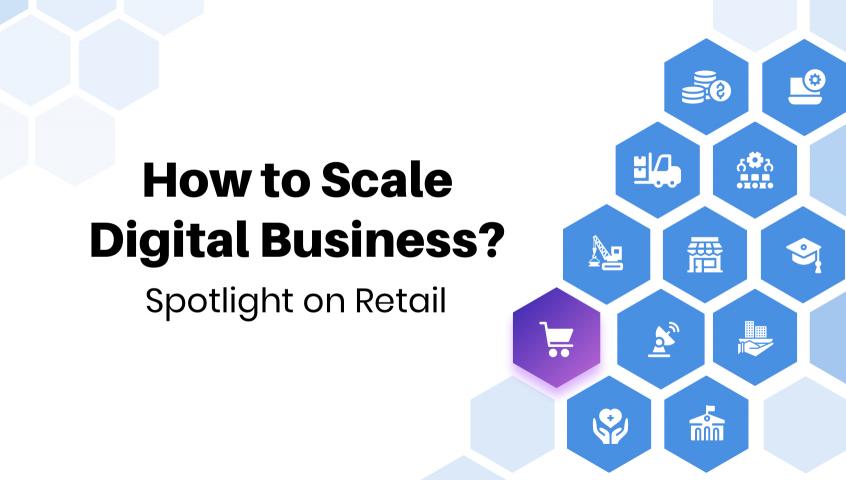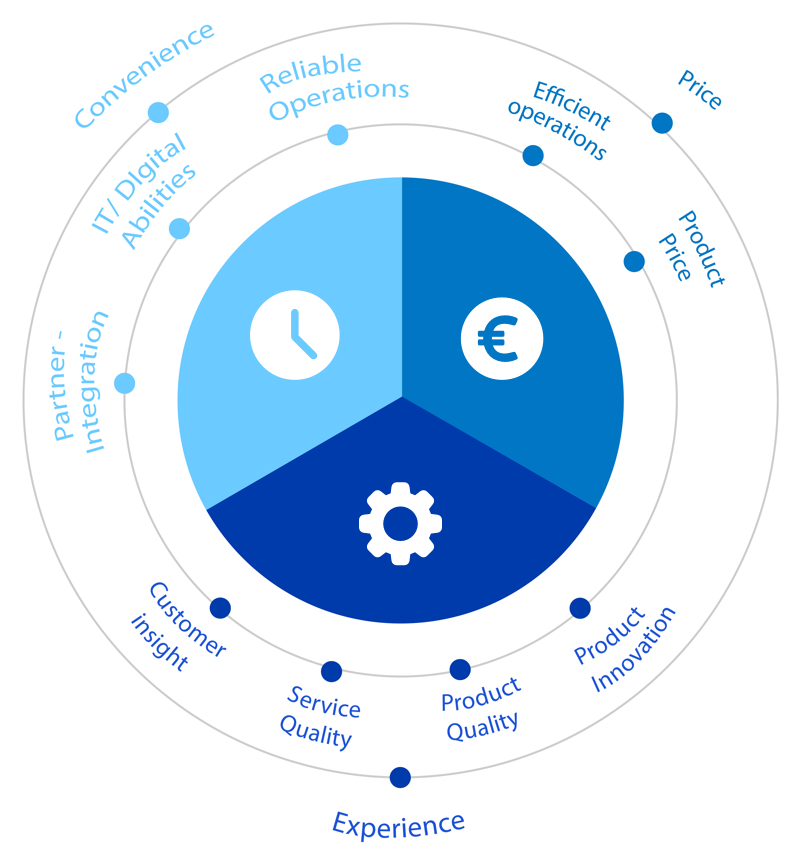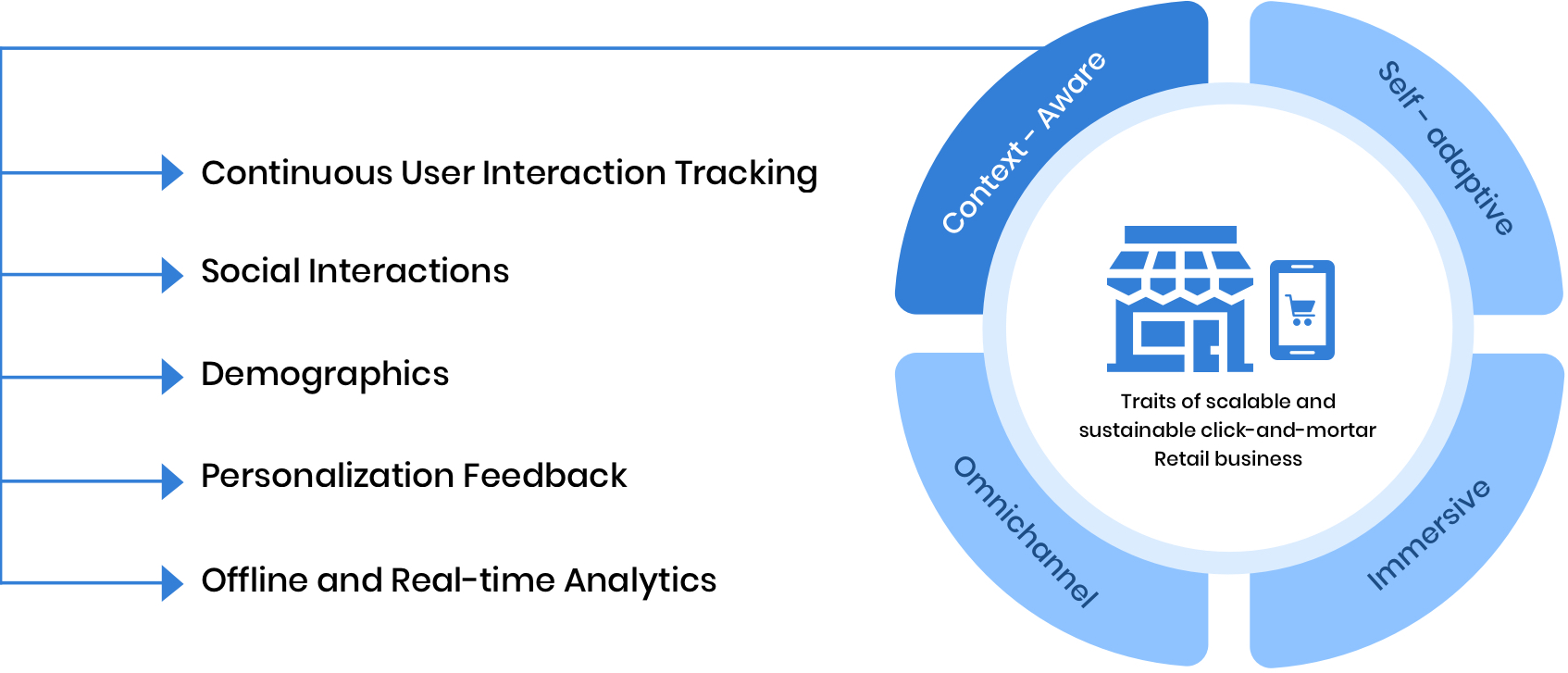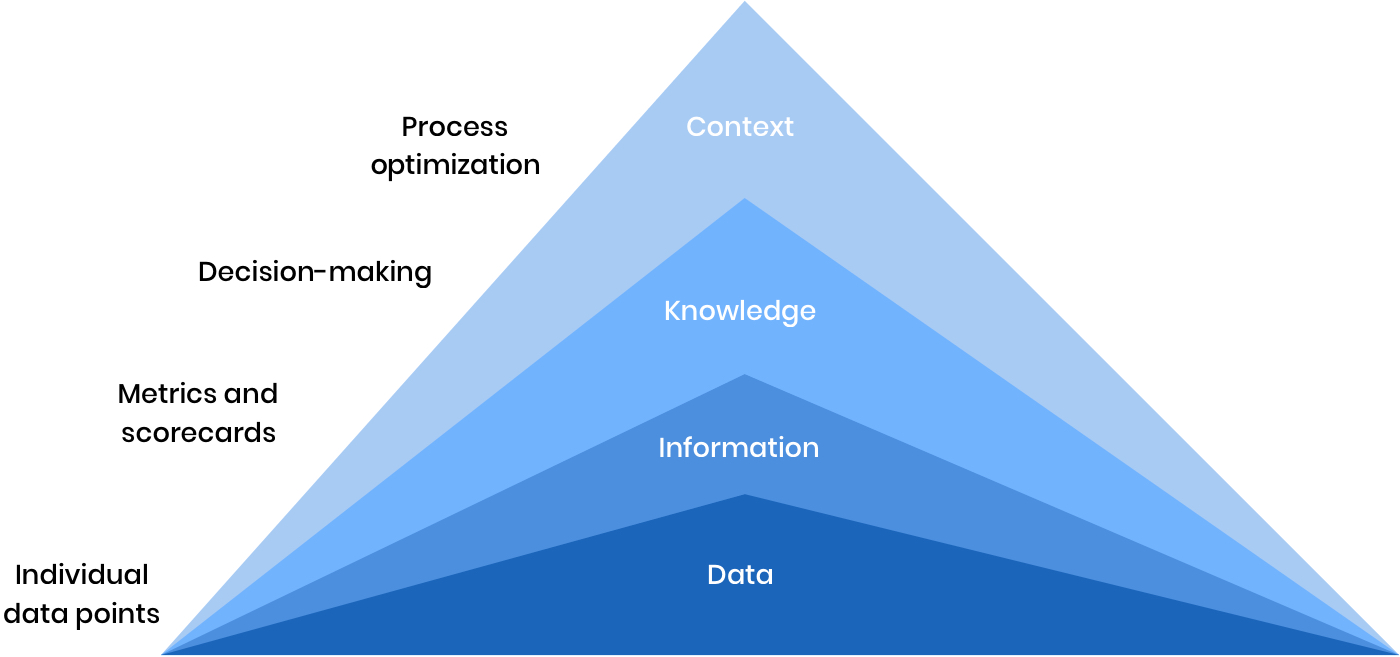
Irrespective of the industry vertical, Digital Presence is an essential for businesses especially after the life-altering pandemic. It is uncertain if we can already say ‘we survived a pandemic’ but whether or not we are back to normal, having a digital presence is the only way for the businesses to stay sustained in 21st century. Most industry leaders are feeling strong about a global economic comeback, but the hopes can only solidify when there is an action towards the ambition. In this series of articles, we plan to present our point of view, observations, and learnings about what can help you strengthen your digital ground, how to expand your possibilities and how to stay relevant in disruptive times. Let us start with an Industry that involves the largest portion of global population, Retail.
We are not only in the midst of a global pandemic but also the fourth global industrial revolution. According to the World Economic Forum, 4IR is characterized by a range of new technologies (such as AI, IoT, genetic engineering, quantum computing, and more) that are blurring lines between physical, digital, and biological worlds. In contrast to the last three industrial revolutions, the fourth one focusses on coping with the changing customer expectations instead of giving ease and convenience to the manufacturer, provider, or supplier.
 With the rise of the Information Technology, Digitization of business offerings and operations has started a couple of decades ago. The first phase of Digitization was all about acquiring marketing, sales, and usage data from the customers and using it for further enhancements. The second phase of Digitization encouraged entrepreneurs to have a digital presence via various channels, use digital platforms to interact with the customers, offering digital experiences and of course collecting and analyzing contextual data at each point. Now it is time to evolve into the next phase, which is all about extreme personalization, hyper automation, and expanding the business ecosystem digitally. Scaling a digital retail business involves a constant re-evaluation of 3 aspects – Convenience, Experience, and Price.
With the rise of the Information Technology, Digitization of business offerings and operations has started a couple of decades ago. The first phase of Digitization was all about acquiring marketing, sales, and usage data from the customers and using it for further enhancements. The second phase of Digitization encouraged entrepreneurs to have a digital presence via various channels, use digital platforms to interact with the customers, offering digital experiences and of course collecting and analyzing contextual data at each point. Now it is time to evolve into the next phase, which is all about extreme personalization, hyper automation, and expanding the business ecosystem digitally. Scaling a digital retail business involves a constant re-evaluation of 3 aspects – Convenience, Experience, and Price.
Whether it is to expand your customer base or to cut down expenses or just because of peer pressure, if you are already engaged in Digital Transformation initiatives for your business, this article is to help you scale your digital venture(s) with a practical, sustainable, and fool-proof action plan.
Here’s how your digital retail business can prepare to win in the digital-first world. There is no particular order to do the following. Pick any or many that suits your organizational readiness, digital maturity, and business objectives.
Aim for tight-knit Digital-Physical mashup
A good portion of the retailers today fall under Click and Mortar businesses i.e., businesses that operate at both physical as well as digital channels. It is a common observation that a product’s prices are comparatively lesser when the customer buys it online because of lesser operational expenditure. This is fair but this only works when your online presence is a shared marketplace (such as amazon). Say you have your own ecommerce website or an application where you sell the same products/services as your physical store. Your customer often wonders when they can purchase the product online and get it shipped to the store and pick it up from there, why can’t they buy the same product that is readily available in the store for online price?
This price gap is only the tip of the iceberg. We are all striving for omni-channel experience and often ignore the fact that your physical store is a channel too. The experience, convenience, and satisfaction you try to create for your online channel should resonate with the attitude of your physical stores as well. Here’s what you can do.
Re-look at your business strategy. Find a new USP.
I think products has stopped being USP a while ago. There are numerous instances where a company’s unique product has been copied by an offcomer and the later gained popularity leaving the original inventor behind. So, you may turn a few heads around with your exciting new product, but it can’t be your long-term sustainable option to gain a competitive edge. But if you plan well and partner with the right technologies, Physical-Digital fusion aka Phygital can be your thing.
For example, many optics such as Clearly and Lenskart has started treating their physical stores more as learning and experience labs where the customers can come and try the frame, learn about the lens and glasses while the purchase happens on their digital platform. The customers get a customized brand-new product that can be delivered either to their home address or the store address based on their comfort. Since ordering a new pair of glasses would any way take 3 to 4 days to make, the customers won’t even notice the difference. Many other retailers are exploring ways to create such experiences and if you didn’t think about it yet, may be its time you do.
Don’t start from scratch. Rather, find the right digital mate for your physical offerings.
Did you know, although Thomas Alva Edison is often credited for the invention of light bulb, his actual invention was the system that can make incandescent bulbs work and last long. Light bulbs did exist for over 40 years before Edison’s patent he just made them simpler, viable, and economical. My advice for your digital retail business is the same.
Do not reinvent the clock. Just find the right new spark that’ll make your product/service more usable. In addition to their irresistible complimentary beauty make overs, Sephora has other unique ways to keep their customer engaged during each interaction with the brand. When the customer is in the store, they can use the in-store tablet to access their Beauty bag where they can try new products digitally, explore the product details, wish list them or even purchase right there. This feature gained popularity during 2020 when the brand couldn’t offer make up product trials like they used to, due to sanity reasons. But it gives the customers a chance to add more products to their wish list which works as a reminder to buy them at some point.
Transform the way you approach innovation.
Technology companies these days are practicing and promoting the concept of multi-functional teams in their centers of excellence to boost innovation. This can be very well adopted by any other industry who wants to get a true 360-degree insight about their customer while investing in something new. Every business has various departments taking care of various aspects of their brand-customer interaction. Each department has a unique information about the customer which can add value to another department’s plans of initiatives.
Here is a yet another example to demonstrate how Disney continues to stay on top of their game. Disney’s Disney Parks website is not only device-optimized to its intricate details, but it also takes trip planning to a different level. Disneyland is a dream destination to many, but it is a tedious task to plan the dates, check the rides, buy tickets, schedule the tour, and so on and on. But Disney managed to pull everything together into one app. My Disney Experience tool can take care of everything from fast pass to, ride tickets, to scheduled attractions and everything in between. Also, they offer a Magic Band Program which acts as room key, gathers photos clicked at each attraction and food ordering app and Fast Pass integration tool. This is made possible by creating a collaboration between tens of departments, hundreds of devices using a few technologies and one strong intention – ultimate Customer Experience.
Not just digital-savvy workforce. Build digital-savvy C-suite.
If you believe only CIOs and CTOs need to be digitally literate, you might need a sit-down talk. Recruiting best of market profiles won’t get you the expected results if you don’t understand their ideas, proposals, obstacles, and true capabilities. Irrespective of your business’ depth of digital presence, the decision makers should start pursuing digital literacy and gain relevant technology familiarity. Otherwise, a brilliant idea that has the capacity to place you on top of the chart may get dismissed in the board room because it involves a technology that isn’t widely popular or sounds risky and costly.
A recent survey conducted by MIT showed that over 82% of IT executives believe that leaders in the new economy need to be digitally savvy, yet sadly only less than 10% of respondents could strongly agree that their organizations have leaders with the right skills and expertise to thrive in the competitive digital economy.
Embed contextual awareness in your products
Thee is a common assumption that Contextual Awareness is only relevant to Marketing. We beg to differ. As businesses are leaving no stone unturned to prove their customers that they understand them better, not just the messaging but the product/service that you offer should have much smaller and more targeted groups. Your customer’s shopping behavior is changing more rapidly than before.

There are many factors that drive their decision – social conditions, economic condition, weather, internet, price, many more. So, tracking their behaviors also should happen as close as possible to real-time. The next generation of retailers should start working on context-aware, self-adaptive, immersive, and omnichannel retail strategies.
Some of the popular sources for Customer Profile data
- Purchase history
- Transactional data
- Clickstream data
- Social media data
- Customer journey data
- Customer service/support data
- Channel preferences
- Market segment data
- A/B Testing data
- Sentiment data
- Demographics
- Psychographics
It is generally presumed that only eCommerce businesses have the advantage of screening and tracking consumer behavior. But the click-and-mortar companies have access to wider consumer data that just need right technology integrations to be mined. Taking advantage of latest developments in IoT, Big Data, Artificial Intelligence and Machine Learning, it is possible to gather first-hand data that can lay out a contextual landscape necessary for scalable innovations. When New York based CX management agency ICMI conducted a survey, 74% of the customers say that the companies don’t meet their desired timeline for delivering services and yet nearly 42% of the organizations doesn’t have a customer experience leader.

![]() Scaling your product line or investing in innovation without understanding what your customers are expecting is a risky blind bet.
Scaling your product line or investing in innovation without understanding what your customers are expecting is a risky blind bet.![]()
Collaboration is the fastest way to scale
Every brand’s digital presence has its own customers, followers, influencers and observers. Finding smart collaboration opportunities with your fellow retailers, suppliers, or consumers can improve operational efficiency, uplift the brand value by unveiling in front of a larger set of digital audience, makes the business landscape more dynamic, boosts innovations, and gives you a closer look of your customers and competitors. So, what’s not to love? Here are some of the probable collaboration models.
Retailer-Supplier
Retail brand with strong supplier collaboration tend to outperform their peers. Here are some retailers who are one step ahead in bonding with their suppliers for bigger benefits. The British consumer goods company Unilever partnered with a Denmark-based enzymes supplier Novozyme to innovate bio-detergent formulations that works well at lower temperatures, helping consumers to save energy and reduce CO2 emissions. Cosmetics retailer L’Oréal conducts an annual supplier-exclusive exhibition and trust-based forum to give them a preview of consumer trends and new product ideas to encourage them to come up with more innovative packaging solutions.
Retailer-Retailer
As almost all the retail businesses went (had to go) on a full digital mode since 2020, cross-brand collaborations and strategic partnerships were on full swing to create bigger footprints. Nike and Apple’s co-branding campaigns started back in early 2000’s when the first generation of iPods were gaining popularity. Latest form of this partnership is Nike+ which is being marketed as ‘your ultimate running partner’. The sports manufacturer embedded activity tracking and sensor technology into their special line of athletic clothing and gear that syncs with Apple iPhone apps to track and record workout data. The retail mammoth Walmart is partnered with eCommerce platforms like Flipkart to sell their collection online tapping on digital opportunities.
Retailer-Consumer
In the mysterious digital world, where getting to know the customer is the biggest challenge of all, why not ask them directly? This is not a new trend. More than a few brands have tried and succeeded by collaborating with their own customers. Lego is a pro in connecting with its customers. This Danish toy manufacturer and retailer has an online forum for its members to showcase their creations and explore others’ too. The popular chocolate brand Cadbury has recently launched an online campaign inviting its consumers to co-create new and unexpected flavor mixes for their new line of chocolate bars.
Reinvent your Business model
Whether you are a digital native or turned digital mid-way, it is important to establish digital capacities right at the core of your business model. You need to have the right channels, technology integrations, infrastructure, governance models, and digital talent to be able to scale your business as and when you need it.
Here’s your basic check list.
- Are your cost structures, operating models, and supply-chain models transparent and flexible?
- Do you have adequate Data and Cyber security? What about your suppliers and technology partners?
- Did you start employing automation?
- Is your workforce and leadership teams digitally literate?
Consumers are constantly expecting innovative products with more flexible and convenient shopping experiences. ‘Go big or go home’ is not relevant anymore. It is ‘Get better or go home’. Today, it is all about blurring the lines between physical and digital world and you need strategy, technology, and people to win this. Mckinsey declared 3 Don’ts that every bold digital company should follow, and we couldn’t agree more with them.
Are you not certain if your retail business is ready to face the next phase of Digital Revolution? We have a team of experts constantly working on finding effective strategies for digital businesses. Drop us an email today and let’s have a conversation. info@qentelli.com

